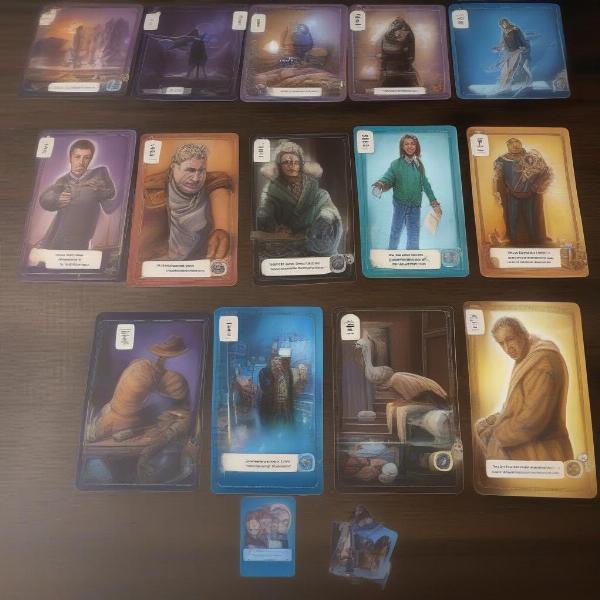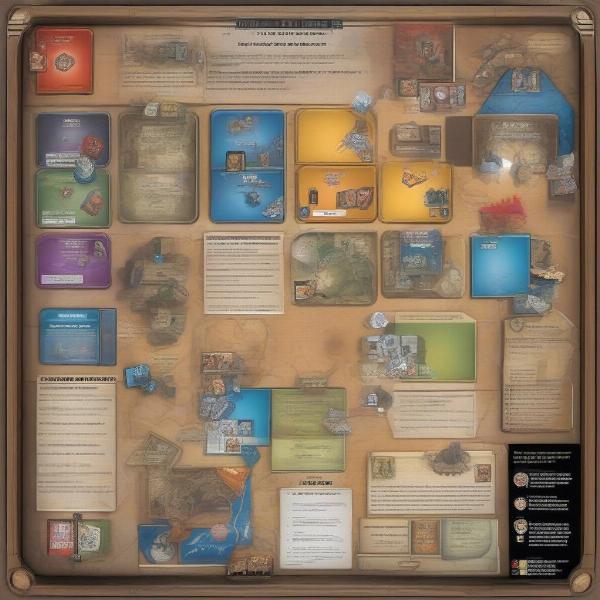The “Who Goes There?” board game, based on John W. Campbell Jr.’s novella “Who Goes There?”, plunges players into a thrilling world of suspicion, paranoia, and alien imitation. This chilling game of hidden identity and deduction challenges players to survive in the desolate Antarctic, where a shapeshifting alien lurks among them.
As a dedicated gamer and administrator of playperf.blog, I’ve spent countless hours exploring the depths of this captivating game. From strategic gameplay to the chilling atmosphere, “Who Goes There?” offers a unique and engaging experience unlike any other. This comprehensive guide will delve into every aspect of the game, equipping you with the knowledge and strategies you need to survive the Antarctic nightmare.
Unveiling the Secrets: Understanding “Who Goes There?” Gameplay
“Who Goes There?” isn’t your typical board game. It’s a tense experience where trust is a fragile commodity and every decision could mean the difference between life and death. Players take on the roles of scientists and support staff stationed at a remote Antarctic outpost. However, one or more of them may be infected by the Thing, a parasitic alien capable of perfectly imitating its human hosts.
The game progresses through a series of rounds, each consisting of actions, events, and the ever-present threat of the Thing’s spread. Players must work together to complete vital tasks, gather resources, and ultimately escape the outpost. But the insidious nature of the Thing adds layers of complexity and mistrust. Can you truly rely on your fellow players, or are they harboring a monstrous secret? The thrilling challenge of “Who Goes There?” lies in deciphering friend from foe amidst the growing paranoia. For a deeper understanding of similar social deduction mechanics, check out our guide on how to play traitors board game.
What Makes “Who Goes There?” So Captivating?
The game’s immersive atmosphere, fueled by the constant fear of the unknown, is a major draw. The chilling artwork and detailed components transport players to the desolate Antarctic landscape, where the isolation and paranoia become palpable.
But the true brilliance of “Who Goes There?” lies in its intricate gameplay mechanics. The infection mechanism, the limited communication, and the constant need for vigilance create an experience that keeps players on the edge of their seats. Every rustle, every glance, every hesitation becomes a potential sign of infection. This game is more than just rolling dice and moving pieces; it’s a psychological thriller played out on the tabletop.
The Importance of Character Roles in “Who Goes There?”
Each character in “Who Goes There?” possesses unique abilities and starting items, adding depth to the strategic element. Understanding the strengths and weaknesses of each character is crucial for survival. Whether you’re a resourceful scientist, a skilled mechanic, or a resilient leader, your role will influence how you approach the challenges ahead. Some characters are better suited for exploration, while others excel at combat or research. Choosing the right actions and utilizing your character’s abilities effectively can be the key to uncovering the Thing and escaping the outpost.
 Character Cards from Who Goes There? Board Game
Character Cards from Who Goes There? Board Game
Navigating the Antarctic Nightmare: Essential Strategies for “Who Goes There?”
Survival in “Who Goes There?” demands more than just luck; it requires cunning, strategy, and a healthy dose of paranoia. Here are some key strategies to help you navigate the treacherous landscape and uncover the Thing before it’s too late:
- Observation is key: Pay close attention to the actions and behavior of your fellow players. Are they acting suspiciously? Are their movements erratic? Even the slightest inconsistency can be a telltale sign of infection.
- Communication is crucial, but trust no one completely: While collaboration is essential for completing tasks and gathering resources, remember that anyone could be infected. Share information cautiously and be wary of those who seem too eager to cooperate. You might find parallels between this and the dynamics in what is 7 minutes in heaven game, although the context is drastically different.
- Utilize your character’s abilities wisely: Each character has unique strengths that can be leveraged to your advantage. Whether it’s using a mechanic’s skills to repair vital equipment or a scientist’s expertise to analyze samples, knowing when and how to use your abilities can make all the difference.
Mastering the Art of the Blood Test: A Crucial Tool for Survival
One of the most important tools at your disposal is the blood test. This allows you to test samples from other players, potentially revealing their true nature. However, blood tests are limited, so use them strategically. Testing the wrong person at the wrong time can have dire consequences. Knowing when to bluff and when to trust your gut is a vital skill in this game. Consider the implications before performing a blood test, and always be prepared for the unexpected.
 Performing a Blood Test in Who Goes There?
Performing a Blood Test in Who Goes There?
Beyond the Basics: Advanced Tactics and Considerations
As you become more familiar with “Who Goes There?”, you can explore more advanced tactics to enhance your chances of survival. These strategies involve a deeper understanding of the game mechanics and a willingness to take calculated risks.
- Bluffing and Deception: Even if you’re not infected, sometimes the best strategy is to sow discord and mistrust among the other players. This can divert suspicion away from yourself and create chaos that benefits the Thing.
- Resource Management: Resources are scarce in the Antarctic, and managing them effectively is essential for survival. Prioritize tasks that gather vital supplies and avoid wasting precious resources on unnecessary actions.
- Long-Term Planning: While reacting to immediate threats is important, don’t lose sight of the overall objective: escape. Develop a long-term plan that accounts for the Thing’s potential spread and the dwindling resources. Just like managing your gaming setup, which might involve knowing how to turn off game mode on mac, strategic planning is key in “Who Goes There?”.
The Psychological Element: Managing Paranoia and Mistrust
The psychological aspect of “Who Goes There?” is just as important as the strategic gameplay. Managing your own paranoia and deciphering the motivations of others is crucial for survival. Don’t let fear cloud your judgment, but also don’t be too trusting. Finding the right balance between caution and cooperation is the key to navigating the Antarctic nightmare.
“Dr. Emily Carter, a renowned psychologist specializing in extreme environments, emphasizes the psychological impact of the game: ‘The isolation and uncertainty inherent in ‘Who Goes There?’ create a powerful psychological experience. Players must grapple with their own paranoia and learn to trust their instincts in order to survive.'”
The Legacy of “Who Goes There?”: From Novella to Board Game
The “Who Goes There?” board game faithfully captures the spirit of John W. Campbell Jr.’s classic novella, bringing its chilling narrative to life on the tabletop. The game’s immersive atmosphere, intricate gameplay, and psychological depth have earned it a dedicated following among board game enthusiasts. From the desolate Antarctic setting to the ever-present threat of the Thing, “Who Goes There?” offers a unique and unforgettable gaming experience. Similar to understanding game durations in other titles, like how long does a csgo game last, knowing the source material adds another layer of appreciation for “Who Goes There?”.
Who Goes There? Board Game Variants and Expansions
The base game offers a thrilling experience, but for those seeking even more challenges and variety, several expansions and fan-made variants exist. These can introduce new characters, gameplay mechanics, and even alternative scenarios, further deepening the strategic possibilities and the chilling atmosphere.
“Professor David Miller, a leading expert in game design, comments on the game’s enduring appeal: ‘The elegant design and thematic richness of ‘Who Goes There?’ have allowed it to remain relevant and engaging for years. The game’s adaptability to different play styles and its capacity for expansion have ensured its continued popularity among board game enthusiasts.'”
 Game Components of Who Goes There?
Game Components of Who Goes There?
Conclusion: Embracing the Paranoia and Thrills of “Who Goes There?”
The “Who Goes There?” board game offers a unique blend of hidden identity, strategic deduction, and psychological tension. Whether you’re a seasoned board game veteran or a newcomer to the genre, this chilling game is sure to provide hours of thrilling gameplay. So gather your friends, brace yourselves for the Antarctic cold, and prepare to face the ultimate test of trust and survival in the “Who Goes There?” board game.
FAQ
- How many players can play “Who Goes There?”? The game is designed for 3-8 players.
- How long does a typical game of “Who Goes There?” last? Gameplay typically ranges from 60-90 minutes.
- Is the “Who Goes There?” board game suitable for beginners? While the rules are relatively straightforward, the strategic depth and psychological elements may be more challenging for new players.
- Are there any expansions available for “Who Goes There?”? Yes, there are expansions that introduce new characters, locations, and gameplay mechanics.
- Where can I purchase the “Who Goes There?” board game? The game is available at various online retailers and specialty game stores.
- What is the age recommendation for “Who Goes There?”? The game is recommended for ages 13 and up.
- Is the “Who Goes There?” board game based on a book? Yes, it is based on the novella “Who Goes There?” by John W. Campbell Jr., which also inspired the movie “The Thing”.

